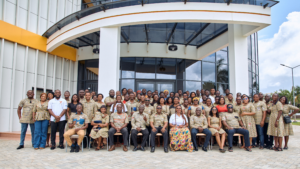Lightening Maternal and Child Health Issues in West Mamprusi District ; the Panasonic Story
The Northern Region of Ghana per the 2010 population and housing census, has a total population of 2,479,461 out of the 24,658,823 national figures. The region has the largest land mass of 70,384 square km or 31 percent of the seize of the country, yet it is among the three regions with worse health indicators and among the poorest in the country.
The West Mamprusi District is situated in the Eastern part of the Northern Region and has a total population of 121,117. Sixty three percent of the population live in rural areas with children constituting 49.5 percent of the household structure. Illiteracy rate in the West Mamprusi District is as high as 60.1 percent of the population , thus over half of the population can neither read nor write. The main source of lighting for most housing units in the district at night is kerosene lamps, (41.1%). Only 16.5 percent of the rural dwellers are connected to the national electricity grid (GSS, 2010).
Planned Parenthood Association of Ghana (PPAG), a leading Non-Governmental Organization in the country in the provision of sexual and reproductive health information and services established a clinic in Kparigu in the West Mamprusi District in the year 2000 to cater for the reproductive health needs of the people.
Since then, over 20 communities with population of over 30,000 people access reproductive health services including maternal and child health care at the clinic. The clinic had sponsorship from various donors including USAID and International Planned Parenthood Federation(IPPF).
 The most recent donor is the Government of Japan (GoJ) through the Japanese Trust Fund (JTF) with support from the Panasonic Company of Japan.
The most recent donor is the Government of Japan (GoJ) through the Japanese Trust Fund (JTF) with support from the Panasonic Company of Japan.
A Public Private Partnership (PPP) deal between the GoJ, IPPF and Panasonic Company introduced an innovative intervention that saw Panasonic providing solar lanterns to most households within the rural settings of the district. The objectives of the project were as follows:
- To increase the utilization of integrated Sexual and Reproductive Health(SRH) and HIV services, including safe motherhood and family planning among women, men and young people in the project communities by 20 percent by March 2015 (using base figure from baseline survey)
- To increase access to integrated and continued child health services by 20 percent (using base figure from baseline survey) to ensure newborn survival by the end of March 2015
- To improve the economic status of 500 girls and women in the project area through the provision of microcredit facilities as a way of addressing poverty-related barrier to SRH/HIV services by the end of March 2015
- To strengthen PPAG’s partnership with Japanese private sector by piloting 300 Panasonic solar lanterns and Saraya’s products by 2015
A total of 320 lanterns were supplied to the poorest of the poor within Kparigu and 19 surrounding communities. Also, six health facilities within the project’s catchment area were given lanterns to help them comfortably operate at night.
In a bid to tie in this social intervention with reproductive health, PPAG introduced the Panasonic Solar Night Discussions (PSND). The activity is such that, families gathered around the Panasonic Solar Lanterns in the evenings, at least thrice in a week, to have SRHR discussions guided by trained Community Based Services (CBS) Agents.
Issues discussed during such nights included pregnancy and child bearing, contraception and contraceptives, safe abortion, HIV and AIDS, menstruation, relationship, personal hygiene among others.
It was exciting to see how women broke the power relation between them and their male counterparts to contribute meaningfully to reproductive health issues affecting them. Gender parity was promoted in most cases in these discussions; this especially was very instrumental in making men appreciate the contribution of their spouses and women in general to the development of their communities. The communities were mainly male dominant and hitherto women had little to say when it came to issues such as how many children a woman should have, when to go for antennal care, where to deliver and whether or not to use contraceptives among others.
In addition to the solar lanterns, the Japanese Trust Fund supported women in this area through micro finance so that they could engage in some income generating activities (IGA) in order to break poverty related barriers to SRHR information and services. The women were encouraged to turn around their seed capital either individually or in groups, make some profits and pay $50 each, over six months, for the lanterns so as to enable PPAG purchase more lanterns from Panasonic to expand the programme to other deprived households.
- Beneficiaries of the project had their SRHR knowledge and skills enhanced through the Panasonic Solar Night Discussions (PSND).
- Households were exposed to accurate SRHR information and this helped improved their health seeking behaviours . Demands for contraceptives increased, supervised deliveries as well as male involvement in SRHR Programmes also increased.
- The people in the project area especially women can light the paths to the nearest clinics during health emergency cases at night. This prevented needless deaths and disabilities and improved on the health status of the people
- Households that benefitted from the lanterns interacted late into the night because their compounds were lit and therefore they did not have to worry about crippling animals such as scorpions and snakes which were very common in the area. This improved relationships in the families because they had more time to interact than before.
- Hitherto, people went to bed straight after taking dinner allowing no space for a little digestion before bed and that obviously affected their health.
- The lanterns also enhanced the execution of social activities such as funerals, festivals and health durbars at night. Two or three Solar Lanterns mobilised from different households were enough to brighten parks and durbar grounds for social activities, thus improving the socialization among the people in the project area.
- The lanterns were also used by school children to learn and complete home assignments given them from school. In the long run, the high illiteracy level (60.1%) in the area can be reduced as children would have more time to study and those who cannot go to school at day can enrol into non-formal education systems (night schools).
- The lanterns enabled women to carry out economic activities at night and dawn such as trading and picking or cracking shear nuts, groundnuts and other farm produce. This certainly would go a long way to improve on the economic status of the people especially women.
- Maternal and child health also improved over the period as lactating mothers were able to comfortably breastfeed their babies at any time of the night. Mothers who also returned late at night from their farms and trading places were also able to cook for their families using the lanterns, this impacted positively on the nutritional status of their families especially that of children
The PPP arrangement was the first of its kind in the West Mamprusi District and the implementation process revealed how crucial it is for the private sector to support government and Civil Society Organizations (CSOs) to improve the health status of the people. Much as the Panasonic Company supported to touch and improve the livelihood of the people, it also expanded its market for its products. Over two hundred and fifty households were able to pay for the lanterns as of November 2015, implying that, more lanterns would be purchased from the company, thus a win-win situation.
As donor funding is seriously dwindling, the Panasonic project can be an eye-opener for CSOs to diversify their sources of funding as they work towards improving the lives of women and children in deprived communities.

A picture after interacting with women beneficiaries during a monitoring trip


